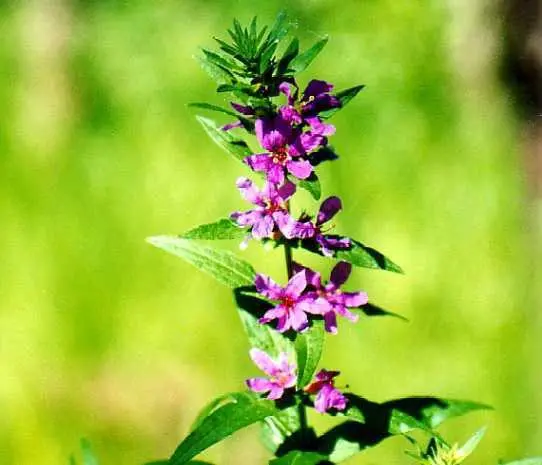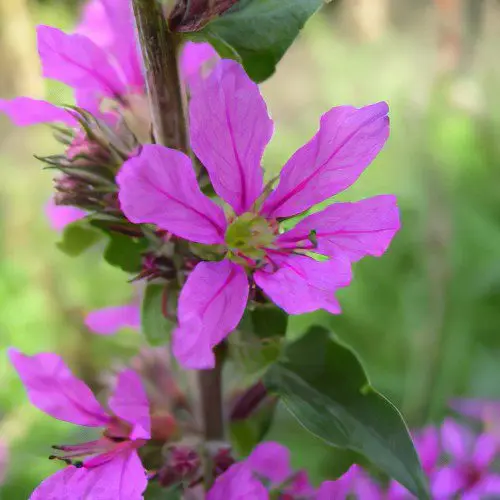Useful properties, application and cultivation of loosestrife (plakun-grass)
Botanical characteristics of loosestrife loosestrife

Derbennik ivolistny is a perennial herbaceous plant with an erect tetrahedral stem 50–150 cm high, often growing into large but loose clumps. It is characterized by a creeping woody rhizome and purple-lilac spike-shaped inflorescences, located in the axils of the bracts. The leaves are lanceolate, green in summer and red in autumn.
Loosestrife grows everywhere, preferring sunny places with moist soils. Starting in July, this honey plant blooms with bright beautiful flowers, attracting many butterflies and bees. Honey collected from loosestrife is very fragrant, it has a rich amber color and a slightly tart taste. At the end of August, the fruits are already ripening, which are oblong rounded boxes filled with small seeds.
Useful properties of loosestrife
The loosestrife contains flavonoids, polyfinol, glucosides, tannins (tannins), phenol carboxylic acids, essential oil, and vitamins. The flowers of the plant are rich in anthocyanins, and the roots are rich in saponins. The aerial part of the plant is usually harvested before flowering, the roots are dug up in the fall. Once a year, on Ivan Kupala, at the hour of dawn, it is allowed to harvest both at the same time.
Looseberry has an antiseptic, hemostatic, tonic, wound healing, anti-inflammatory and soothing effect. If you fill the pillow with the leaves and flowers of the plant, then the dream will be deep and calm.
The use of loosestrife
For medicinal purposes, leaves, roots, seeds and flowers of loosestrife are used. A decoction of the roots is good for diseases of the upper respiratory tract, convulsions, headaches and toxicosis in pregnant women. Infusions from the aerial part improve the patient’s condition in diseases of the gastrointestinal tract, prostatitis, hemorrhoids, rheumatism, epilepsy, nervousness.
The polyphenols contained in the plant help in the treatment of venous insufficiency, tannins weaken the action of alkaloids and heavy metal salts, temporarily precipitating and binding them. Further medical intervention is required to completely remove the formed poisonous sediment.
Infusions can also be used externally for varicose ulcers and eczema, bruises and wounds. Tea from the roots and flowers of loosestrife relieves headaches.
Decoction of loosestrife: 1 tablespoon of chopped fresh herbs is required to pour a glass of boiled water and put on a “steam bath” for 10-15 minutes. The mixture should be infused for 45 minutes and only after that the broth is filtered. A decoction is taken in a warm form, 1/4 cup (50 mg) 3 times a day.
Infusion: 2-3 tablespoons of dry chopped loosestrife grass is poured with a glass of boiling water, insisted for four hours and filtered. The resulting infusion is consumed 50 mg (1/4 cup) 3 times a day.
Growing loosestrife

Moist soils rich in humus are best suited for loosestrife. He also loves sunny places, in the shade his flowering will not be so bright and plentiful. Acidic substrates are exactly what is needed for plant growth, therefore, when planting loosestrife in the soil, it would be nice to dilute it with high-moor peat – up to 10 buckets per 1 m2. Such a mixture will not only supply the plants with nutrients, but also retain moisture well in the hot season.
To keep moisture even better in the soil, you can use mulching with loose compost. Regular feeding of the plant with a complete fertilizer is also desirable. It should also be taken into account that the loosestrife loves aphids, so it is necessary to take preventive measures in time. For spraying, you can use an infusion of onion peel, tomato leaves, garlic, citrus peels or tobacco.
Bushes can be formed by slightly pinching the shoots growing in the undesirable direction; in autumn or spring, all stems are cut short. The loosestrife propagates by seeds, cuttings or by dividing the bush, carried out in early summer. Seeds for seedlings are sown in the ground (under the film) in March-April.
Looseflower flowers
The loosestrife is a wild plant, but it can be grown in flowerbeds, near a pond and in a garden. Most often, for decorative purposes, willowy and twig-shaped loosestrife are planted, differing among themselves in the height of the stem and the color of the flowers. Quite often they are used in group plantings, they are valued for long abundant flowering and unpretentiousness.
Loosestrifes go well with such perennials as cuff, elecampane, meadowsweet, volzhanka, loosestrife.
Derbennik – “plakun-grass”
People say about the loosestrife that “in the mornings he cries with transparent tears”, for which he was called the weeping grass. But everything is explained simply! On the reverse side of the leaves there are special stomata through which excess moisture is removed, because this plant loves damp places very much.
For medicinal purposes, all parts of the loosestrife are used. The roots are carefully dug up, and the tops of the stems with flowers are cut off with scissors and dried in the open air under an awning. It is used for colds, general weakness, diseases of the nervous system and gastrointestinal tract, for bleeding, ulcers, indigestion, noise in the head, epilepsy. To do this, use decoctions, infusions and tea.
Derbennik “Pink Pearl”
Bright pinkish-purple flowers in the form of dense spike-shaped inflorescences crown the even and straight stem of this perennial winter-hardy plant. Its height varies within 120 cm. Growing, loosestrife forms large curtains that will become a worthy decoration of any flower garden, pond, garden. This species is distributed throughout the Russian Federation. Without transplantation and division, the plant can grow in one place for many years. It hibernates without shelter, however, in autumn the entire ground part is completely cut off.
Often used in folk medicine as a hemostatic agent.
Derbennik rod-shaped

This species differs from loosestrife loosestrife in brighter flowers and compact size. The height of the stem together with the inflorescences is 120 centimeters. Inflorescences are less frequent, there is no pubescence, the stem is branched. The plant can winter without shelter, but in the absence of sufficient snow cover in a frosty winter, it may suffer. It is widely distributed in the temperate zone of Asia and Europe. Different varieties of this type of loosestrife have different shades of pink-raspberry.
The loosestrife is unpretentious, grows well in the sun or in a slightly shaded place, and can tolerate the drying of the substrate. Usually blooms in July-August. The plant propagates by seeds, vegetatively by dividing the bush and basal cuttings in early summer.
For medicinal purposes, the root of the plant is most often used, but if the time for harvesting it has not yet come, then grass is used. An aqueous decoction is drunk for pain in the stomach, uterine bleeding, as a diuretic. Root tincture on vodka is used for colds, headaches, bruises, stomach pains. A decoction is added to baths for bathing malnourished children, with children’s convulsions or nervous diseases. The herb is also used as an astringent. Gruel from a fresh plant is good for bleeding wounds.
Contraindications to the use of loosestrife
Like every remedy, loosestrife has its contraindications. It cannot be used in patients with increased blood clotting, it is contraindicated in atherosclerosis and a tendency to thrombosis. Neither tinctures, nor decoctions, nor fresh herbs are categorically recommended for elderly people with atonic or senile constipation. With great care and only after consulting a doctor, you can use the plant for hypertensive patients, since the herb leads to vasoconstriction. As a result, the pressure can rise even more.









